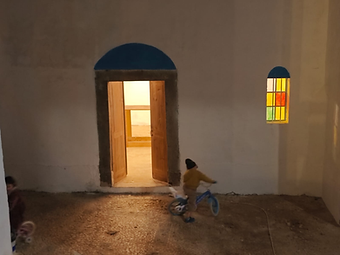
Comunidad judía en Elvas y Badajoz
The synagogue
The synagogue is the only authentic Sephardic synagogue in the entire Iberian Peninsula.
It preserves the ancient traditions that were practiced in Sefarad and throughout the Jewish world— excluding the Ashkenazi communities (namely those originating in France and Germany).
Here we present a few of the unique customs (out of many) observed in our community. Some of these may appear more prominent to the eye, while others may seem minor—but together, like pieces of a puzzle of authentic Sefarad tradition, they form a meaningful and cohesive spiritual structure.
For example, this is currently the only synagogue in all of Sefarad where congregants do not enter with shoes.
There are no chairs or tables; instead, mats are spread wall to wall—following the words of Maimonides (Mishneh Torah, Hilchot Tefilah 11:5):
as Maimonides states (Tefilah 11:5):
בתי כנסיות ובתי מדרשות נוהגין בהן כבוד, מכבדין אותן ומרבצין אותן. ונהגו כל ישראל בספרד ובמערב, בשנער וארץ הצבי, להדליק עששיות בבתי כנסיות, ולהציע בקרקען מחצלות כדי לישב עליהן. ובערי אדום יושבין שם על הכסאות.
"All the Jews in Sefarad, in the west (Morocco, Tunisia and Algeria), Babylonia, and land of Yisrael, are accustomed to light lamps in the synagogue and spread mats over the floor to sit on. In the cities of Edom (Christian Europem namely Ashkenaz), they sit on chairs.”
Before prayer, especially the Shacharit (morning prayer), one must wash—ideally the whole body—but at minimum the face, hands, and feet daily.
Before every prayer, ritual hand-washing (Netilath Yadayim) with a blessing is observed.
Torah reading is performed by the individual who recites the blessings, unlike it is done in the most of the places nowadays.
Those who do not know how to read from the Torah do not approach it. In accordance with ancient tradition, no one reads on behalf of another. Nevertheless, Torah reading classes are available for those who wish to learn.
The prayers are intentionally concise. No additional piyyutim (liturgical poems) are inserted beyond what was instituted by the Sages, in keeping with the principle of avoiding public burden (Torach Tzibbur).
The community uses its own siddur (prayer book), which is based on the rulings and testimony of Maimonides. It is supposed to be translated into Portuguese and Spanish soon.
Lastly, the synagogue itself does not have a mezuzah, as it does not serve as a dwelling place—per Hilchot Mezuzah 6:6—though all surrounding rooms and buildings do have one.
The synangoge is the only authentic Sefarady sinagogue in all of the Iberian peninsuela, it conserve the ancient traditions that were used in Sefarad and all over the Jewish world except for Ashkenaz (namely French and German).
Here we wemention few of the uniqe pecularities for example, some of them might be more prominent to your eyes and some of the might be considered minor, but as a puzzle they all play a big roll in the community.
For example, it is the only synagogue that operate currently in all Sefarad that people do not enter with shoes to the synagogue and the synagogue does not have chairs and tables but mats are spread from wall to wall, as Maimonides states (Tefilah 11:5):
בתי כנסיות ובתי מדרשות נוהגין בהן כבוד, מכבדין אותן ומרבצין אותן. ונהגו כל ישראל בספרד ובמערב, בשנער וארץ הצבי, להדליק עששיות בבתי כנסיות, ולהציע בקרקען מחצלות כדי לישב עליהן. ובערי אדום יושבין שם על הכסאות.
"All the Jews in Sefarad, in the west (Morocco, Tunisia and Algeria), Babylonia, and land of Yisrael, are accustomed to light lamps in the synagogue and spread mats over the floor to sit on. In Ashkenazi Christian cities ('Edom'), they sit on chairs".
-
Before the prayers, especially Shaharith, if not the whole body washed, then at least face hand and legs must be washed on daily basis.
-
Before every prayer 'Netilah' with Blessings (Tefilah)
-
The reading in the Torah is done by each indicidual that bless. People who do not know to read, do not go to the Sefer Torah, and as the old tradition, no one is allowed to read for another person. Anyway, taching for Torah reading are offered to those who are interested.
-
The prayeres are short, No piyutim are allowed to be added to the obligated prayer, since the principle of 'Public nuisance' (טורח ציבור) does allow to add on what Chazal fixed for the public.
-
The community has its own Sidur which based on Maimonides testimony.
-
The synagogue itself does not have Mezuza since it does not have dwelling department (Hilkhoth Mezuza 6,6) but all soorounding have.


